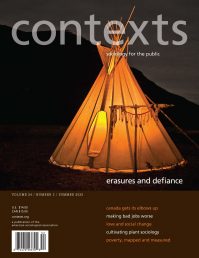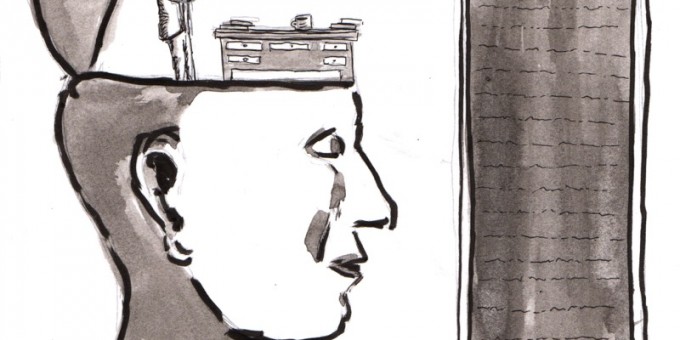
by Sam Grindberg
What’s Biology Got to Do with It
Are biological and sociological accounts of human social behavior inevitably opposed?
Just over a decade ago, a group of self-described “biologically minded sociologists” established an American Sociological Association-sponsored section titled Evolution, Biology, and Society. Their two-fold claim (echoed for many years among anthropologists as well) is that 1) biology is emerging as the dominant science of the twenty-first century and 2) “biophobia” in the social sciences is getting in the way of more fully integrated theories and research in human social behavior.
Critics of this position don’t necessarily disagree with either claim; instead, they point to the disproportionately high research investment in the biological and physical sciences relative to the social sciences. They charge that this funding imbalance is an indicator of a “biomania” that threatens to reduce complex social behavior to natural tendencies. The resulting individualistic models are then used as supporting evidence for increasingly austere neoliberal policies, not to mention homophobia, racism, sexism, and xenophobia.
Both perspectives have some traction. Recent advances in biological inquiries into human behavior—which include fields such as evolutionary biology and psychology, behavioral genetics, and bio-indicators (hormonal and neuroscience measures)—are significant. It is also true that corporations, politicians, and activists of all ilks strategically manipulate biological science to support their interests.
Paradoxically, there are countless examples that the logic of social construction has proliferated into everyday parlance; at the same time, the luster and authority of biological science is a recurrent (and highly marketable) theme in popular culture. All of this signals new twists in the familiar nature versus nurture debate and leads us to ask, is a new bio-socio zeitgeist emerging?
For this Viewpoints, we asked five experts to comment on the biological turn in sociological research. Dalton Conley describes his path to appreciating the potential of integrating genomics into studies of social mobility. In stark contrast, Roger N. Lancaster lambasts the logic of genetic reductionism for explaining cultural institutions.
Alondra Nelson describes the case of the African Burial Ground project in which researchers at Howard University have creatively used genetic comparison to confer a humanizing social life (i.e., to infer ancestral associations and ethnic affiliations) on former slaves who were buried in New York City. This research not only departs from the either/or nature versus nurture debate, it is a notable corrective to the racist classification-based genetics that were typical in the nineteenth and twentieth centuries.
In another twist on the debate, Kristen Springer advocates for the integration of sociological reasoning and biological evidence to explain persistent patterns of gender differentiation. Karl Bryant continues this theme in his discussion of contemporary sociology students who have been schooled to dismiss biology in favor of a fuzzy form of social construction. Both Springer and Bryant contend that sociologists need to be more biologically literate, if only to effectively respond to the misattribution of biological determinants to social behavior. Furthermore, using biologist Anne Fausto-Sterling’s analogy to the helix, they note that biological evidence can be usefully integrated into sociological models for a fuller, more grounded explanation of human behavioral patterns.
- How I Became a Sociogenomicist, by Dalton Conley
- Cultural Institutions Do Not Reduce To Genes, by Roger N. Lancaster
- Genetic Ancestry Testing as an Ethnic Option, by Alondra Nelson
- How Biology Supports Gender as a Social Construction, by Kristen Springer
- Teaching the Nature-Nurture Debate, by Karl Bryant
How I Became a Sociogenomicist
by Dalton Conley
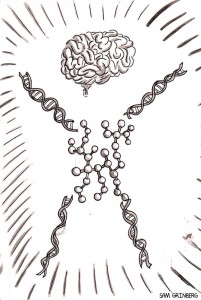
In this clever volume, Mayer deployed a number of counterfactuals and natural experiments to show that the traditional estimates of the effect of income on children’s life chances have been grossly overstated. For example, she showed that a dollar from a transfer payment had little to no effect on children while a dollar from earnings had a much bigger effect—suggesting that it was the underlying attributes of the parents that led them to earn money that were having the positive effect, not the dollars per se. She also showed that additional income did not usually result in the purchase of goods or services that we would expect to improve the human capital or life chances of children. While there were certainly limitations to her work and some questionable assumptions in her models, she upended the world of poverty research as far as I was concerned.
While I went on to publish my book with the appropriate warnings against interpretation of my parental wealth “effects” as causal, the Mayer work sent me off in search of a correctly specified way to assess the impact of parental resources and family conditions on children’s outcomes. This journey led me first to econometrics and labor economics, which I viewed as well ahead of sociology in confronting the issue of endogeneity and selection bias.
Though I found difference-in-differences, instrumental variable, and regression discontinuity approaches helpful in generating more consistent estimates, such approaches all suffered from the limitation that the researcher had to take what she could get in terms of natural experiments. There is—as far as I know—no good instrumental variable for parental wealth, for example. There is no regression discontinuity for race. Even if we considered randomized controlled trials, there remained severe limits to the sort of factors that were adjustable and therefore able to be studied in a causal, counterfactual framework. To quote Penn sociologist Herb Smith, “Nobody denies that the moon causes the tides even though we can’t perform an experiment on it.”
Genetic Endowment — The Lurking Variable
This frustration, in turn, led me to study genetics. The recent addition of genetic markers (single nucleotide polymorphisms or SNPs) to large datasets such as the Health and Retirement Study, the National Longitudinal Survey of Adolescent Health, and the Wisconsin Longitudinal Survey has opened up a new frontier for the social sciences. (Similar efforts are also underway in Europe, for example with the Biobank Project in the United Kingdom and large-scale genotyping of subjects at several European twin registries.) We now enjoy the possibility of directly confronting, measuring and controlling for one of the two main “lurking” variables that bias traditional models of socioeconomic attainment. That lurking variable is, of course, genetic endowment. (The other being the influence of cultural practices that are also transmitted across generations.)
Whether sociologists care one whit about how genetic endowments at conception matter for life chances, how they interact with social environment, and whether they are a random lottery at birth (or rather are socially structured by “tribe”), sociologists should at least want to include genotype in their models in order to better specify the social variables about which we do care. That is, by constructing and including genetic risk scores for outcomes, we can obtain correctly specified, unbiased parameter estimates for the variables (such as education, etc.) that typically interest social scientists.
Furthermore, we can then interact genetic propensity with exogenous environmental variables to go from the adage “a gene for aggression lands you in the board room if you are to the manor born but in prison if you’re from the ghetto” to a robust research agenda on GxE effects. Genotype, in fact, may be the prism by which we come to understand why some individuals react so differently to the same social stimulus—be that a poor neighborhood, a family breakup, or a learning intervention. Heterogeneous treatment effects abound in the social science literature; perhaps innate disposition can provide a rational accounting of them.
In my view, this is potentially one of the next frontiers in stratification research: integrating the big data of genomics with established social scientific models of mobility—using econometric techniques to insure both genotype and environment are indeed exogenous. Rather than police disciplinary boundaries— debating whether it is the left-hand side variable or right-hand side measure (or both) that needs to be purely social to make research sociology—we should embrace any data and any causal pathways that explain the variance in outcomes about which we care. (Interestingly, sociologists seem much more comfortable with epigenetic models that seek to explain how the social environment affects gene expression; it seems the biological is okay when it is the explicandum not the explicator.)
So far, in the emerging subfield of sociogenomics, the worst fears of a deterministic science of human behavior—á la The Bell Curve—have not come to pass. Scientists who have engaged with molecular genetic data have been responsible in their modeling approach and cautious in their claims. Let us hope that these norms take root and continue to guide our work.
Cultural Institutions Do Not Reduce To Genes
by Roger N. Lancaster
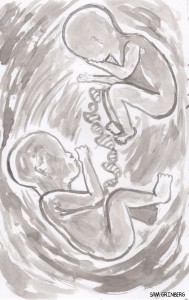
Edsall suggests that genetics, natural selection, and evolutionary psychology might answer a question that has plagued American politics since 1968: “Why do so many poor, working-class and lower-middle-class whites—many of them dependent for survival on government programs—vote for Republicans?” He helpfully points to the voting behavior of West Virginians in the last presidential election: the state’s median family income is 48th in the nation; nearly 1 in 5 of the state’s residents receives food stamps; nearly 1 in 4 will be on Medicaid as the Affordable Care Act takes effect; and 16.4 percent are on disability (the largest percentage in the nation). Yet voters overwhelmingly rejected Obama for Romney.
“Why are we afraid of genetic research?” Edsall muses in conclusion. “To reject or demonize it, especially when exceptional advances in related fields are occurring at an accelerating rate, is to resort to a know-nothing defense.”
The Ill-Logic of Genetic Reductionism
Crowd-pleasing tales about human nature have found a permanent home in psychology, and such stories buttress too much pontification in what passes for a serious public sphere. Permit me to belabor the obvious ill-logic of this reasoning by working from a specific case to general principle.
First, West Virginia has not always been a conservative bastion. The state voted Republican only three times between 1932 and 1996—each time in a general Republican landslide: Eisenhower (1956), Nixon (1972), and Reagan (1984). Only Minnesota posts a similarly Democratic run over the same period. Moreover, West Virginia turned Republican much more slowly than other southern and border states—despite being much whiter (94 percent of the state is non-Hispanic white). No doubt a history of coalminer labor struggles embedded class consciousness in voters’ political reflexes for a long time.
What has happened post-1960s is that the center of liberalism’s gravity has shifted: away from bread-and-butter economic issues to forms of cultural liberalism that emphasize tolerance, diversity, and personal freedoms. Undoubtedly, the preponderantly Scotch-Irish voters of West Virginia love guns and God. Edsall understands this political shift and its implications quite well—far better than most political analysts. But the “Genes” column undermines any insights into the unraveling of the New Deal coalition by turning historical products like clannishness, loyalty, and respect for authority into the fixed biological traits of particular regional or ethnic groups.
Edsell’s reasoning does not withstand even the simplest of logical tests. Note that the descendants of Ulster Scots also are heavily settled in North Carolina and Maine. Obama polled poorly in the rural Piedmont but still carried the Tar Heel State once. He carried Maine twice—and Maine is even whiter than West Virginia. Note too, that Lowland Scotland and Northern England (original homelands of the Ulster Scots) are Labour strongholds, whereas in Northern Ireland, Protestant descendants of the Scots vote Unionist. In short, political consistency is lacking among genetic descendants across different regions. (And even if I were to give Edsall the benefit of the doubt, I would have thought that individualism, insularity, populism, and rebelliousness were more likely traits of Scotch-Irish culture in North America than obedience to authority).
Furthermore, we have seen no “exceptional advances” in fields that attempt to explain social facts by recourse to biological causes. We have seen instead the proliferation and institutionalization of just-so stories—accounts that sound scientific because they’ve got genes and numbers and even sometimes correlations—but that fail the standards of good scholarship and scientific inquiry. Twin studies have played a notorious part in this swindle. Identical twins reared separately have been found to drive the same car models, to smoke the same cigarette brands, and to masturbate over photos of construction workers. Only a rube would believe that there could be “a” “gene” that controls such behaviors. Beware, too, of single studies with small samples and results that lie close to the margin of error: these had established for many the probable existence of “a” “gay” “gene” in the 1990s. Those studies have proved notoriously difficult to replicate—never mind that they reduce a complex and historically constructed institution like homosexuality to a thingified chain of nucleotides.
Anthropologist Marshall Sahlins once quipped that a “theory ought to be judged as much by the ignorance it demands as by the knowledge it purports to afford.” Now, as then, the reduction of social facts to biological facts demands that we forget long histories of migrations, class struggles, ethnic resentments, and institutional changes—that is to say, almost everything that might make social facts intelligible.
Genetic Ancestry Testing as an Ethnic Option
by Alondra Nelson
Combating color-blind racism requires the restoration of color-vision—the return of visibility of inequality. In this “post-racial,” post-genomic moment, DNA offers the unique and paradoxical possibility of magnifying issues of inequality quite literally at a microscopic level.
Diasporic Blacks in the United States are engaged in a constellation of activities in which information about their ancestral origins—inferred with the aid of genetic analysis—is deployed to bring racism’s past and present into view. DNA is a contradictory lexicon for a political moment at which the moral language of social justice increasingly falls on unsympathetic ears.
In 1991 archeologists uncovered several graves on a plot in lower Manhattan. The unearthed burials turned out to be the “Negro Burying Ground,” a former municipal cemetery for the city’s enslaved African population. The rediscovery of this Colonial-era burial ground, with its promise of rare insight into the life and death of enslaved men and women in New York, was an occurrence of historical import.
Following exhumation, the contents of the gravesites were brought to the Lehman College (NY) laboratory for investigation, where the method of analysis consisted primarily of osteology—the scientific measurement of the skeletal remains—and the broad classification of them into several categories, including stature, age, sex, and race. This forensic approach was and remains standard practice among some physical anthropologists and was the perspective that the Lehman researchers brought to the project.
Other researchers, however, including those at Howard University—a historically Black university, found this strictly forensic mode of analysis and interpretation inadequate to the historical significance of the cemetery. Detractors of the Lehman approach, including influential African American physical anthropologist Michael Blakey, who would soon be appointed the project’s new director, contended that the Lehman approach was unduly preoccupied with gross racial classification of the sort also used for criminal justice purposes. He further maintained that this methodology reduced the individuals in the burials to “narrow typologies” and thinly “descriptive variables,” and thereby “disassociated” them from their “particular culture or history.”
Local activists felt similarly. A group who referred to themselves as the Descendants of the African Burial Ground, for example, expressed their opposition to any forensic analysis of the remains that would yield classification of them solely by “skin color”; the activists argued that such an interpretation amounted to the “biological racing” of their ancestors’ remains. Together, the community and the Howard-based researchers pushed for interpretive approaches that would generate more than gross racial sorting of the remains.
Scholar Stephen Jay Gould and others have documented the comparative scientific “mismeasurement” of bodies, from lung capacity to crania to genes—with white bodies serving as the norm against which all others are measured—that has long been employed to advance deliberate and erroneous claims about Black inferiority. Against the backdrop of this bitter legacy of biological discrimination, supporters of the Howard researchers’ analytic method of interpretation sought to upend this history by using biometrics alongside other forms of both scientific and humanistic analysis in order to glean new information about the embodied experience of slavery as well as the particular African origins of some of the earliest Black Americans.
The eventual siting of the African Burial Ground research project at Howard, in response to pressure from the local community, marked not only a new temporary home for the remains while they were being analyzed but, moreover, a fundamental change in the framing of how and why the research was conducted. If the question undergirding the investigations of the Lehman lab could be summarized as “are these the bones of Blacks?” the Howard researchers, to the contrary, sought answers to a more extensive set of questions, including “what are the origins of the population, what was their physical quality of life, and what can the site reveal about the biological and cultural transition from African to African-American identities?”
Blakey’s team hoped to use the rediscovery of these rare remnants of Black colonial life as an opportunity to more fully detail knowledge about how those buried at the African cemetery in lower Manhattan lived and died. At the Howard lab, in other words, the research orientation was shifted from an epistemology of racial classification to an epistemology of ethnicity (and therefore, also ancestry).
Restoring Ethnic Options
According to historian Michael Gomez, the Africans brought to the Americas as slaves during the Middle Passage underwent a “transition, from a socially stratified, ethnically-based identity directly tied to a specific land, to an identity predicated on the concept of race.” In the process, they “exchanged their country marks”—their myriad ethnicities—for a generic, subordinate and collective racial category. Race would in subsequent years become a “master status” for African Americans, a caste location.
Underscoring Gomez’s point from a later historical vantage, sociologist Mary Waters notes that “Black Americans… are highly constrained to identify as blacks, without other options available to them, even when they believe or know that their forebears included many non-blacks.” Thus the opening up of long-denied “ethnic options” to African Americans promised by genetic inference was a potential social watershed.
The African Burial Ground project was among the earliest and most public uses of genetic comparison to infer ancestral associations and ethnic affiliations in the United States. This research and, African Ancestry, the commercial venture it launched, established the groundwork for the social life of DNA; research on the recovered cemetery became a paradigm for how genetics could be used to constitute identity and reconstruct the past, for the circulation of genetic claims beyond the laboratory and the court of law.
The controversy that transpired over excavation methods and research priorities at the centuries’-old African Burial Ground reveals how genetics—despite its vexed trajectory in Black life— can become the building blocks for reconciliation projects that resuscitate public memory of chattel slavery, that shed light on its devastating effects into the present, and that may portend the future of American racial politics.
How Biology Supports Gender as a Social Construction
by Kristen Springer
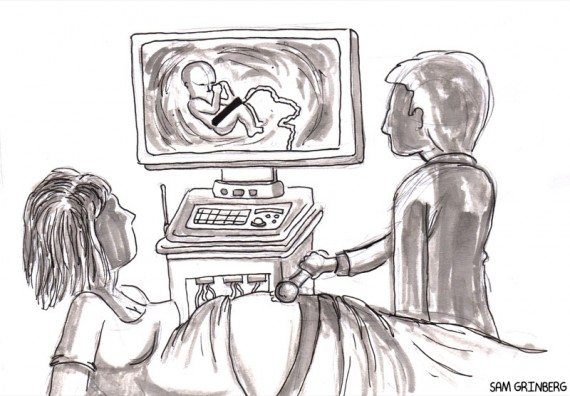
One of the first things asked of any new parent is whether the baby is a boy or a girl. “Gender-reveal” parties are an increasing fad involving events such as slicing a cake to find pink or blue underneath the frosting. Biological sex is now routinely determined in advance of birth either through chromosome tests or ultrasound. However, it isn’t the biology per se that people are interested in—as evidenced by the name “gender” reveal party not “sex” reveal party. Rather, biological identification (sex) signals how the new person will likely be treated and expected to act, and even what its life chances are.
Sociologists, as well as anthropologists and gender scholars, have long bristled at the conflation of sex (biology) and gender assignment (culture), especially to the extent that the latter continues to evoke an array of cultural myths about gender differences that are believed to be rooted in biology—such as men and women having different kinds of intelligence. A high profile example of this thinking is from the now decade-old statement by former Harvard president Lawrence Summers suggesting that fewer women are in engineering in large part because of “intrinsic” (read biological) aptitude differences in math.
Sociologists have worked diligently (and effectively) to demonstrate that biology is not destiny. However, this does not mean that biology is unimportant for sociological understandings of gender. Indeed,
based on my reading and research, I think there are many fruitful ways that biological research can illuminate our understanding of social patterns around gender, but not in the causal way presumed in much research as well as what passes for “common sense.” The challenge is not to throw out biology altogether, but how to integrate it more scientifically into socio-cultural studies of patterned inequalities, such as gender.
More Sameness Than Difference
One fruitful area in this direction is the study of sameness between men and women, rather than difference. The vast majority of biological research on sex and gender continues to focus on differences and to valorize differences as “findings” while dismissing similarities as non-findings. This form of scientific bias is itself a reflection of cultural myths about gender (we expect to see differences and we expect them to be biologically based). Many of these supposed differences do not actually meet scientific criteria for difference.
For example, in 2007, Harvard medical scholar Nikolaos Patsopoulos, and his colleagues published an article in the Journal of the American Medical Association based on their review and analysis of leading published research claiming different genetic effects across sexes. The authors determined that of the 432 sex-difference claims, the vast majority were not actually true and only one (yes, one!) of the 432 published sex-difference claims had strong internal validity and was sufficiently replicated. The focus (and publication of insufficiently substantiated reports) on difference obscures the tremendous similarity between men and women. Paying attention to the biological sameness of men and women rather than the difference illuminates just how much social and structural factors (not biological factors) create the idea of men and women as different.
Another way to incorporate biology into social scientific gender research is to examine the ways in which socio-cultural practices shape bodies, reversing the assumptions of biological essentialism that posit inherent differences between men and women. In other words, used well, biological research can actually support the logic of socially constructed and sustained patterns of difference and inequality.
Biologist and gender scholar Anne Fausto-Sterling is a pioneer in demonstrating the ways in which nature and nurture intertwine, like a helix, to shape what we come to see, socially, as two distinct genders (she posits at least five biologically based sexes).
According to Fausto-Sterling, social practices “shoehorn” bodies into culturally recognizable gender types. Her research on gendering bones is a beautiful illustration of this. Two concrete examples of how bones show gender are the social imperative for women to wear high heels and the historical practice of binding young women’s feet to prevent future foot growth. Both of these practices result in significant differences between men’s and women’s feet bones.
Another way that biology can help us understand how gender is experienced is through analyzing physiological markers as indicators of stress. For example, cortisol is a steroidal hormone that is colloquially referred to as a “stress hormone” because it is released in response to stress—and is particularly susceptible to social evaluation and social threats. Other cardiac and vascular measures can also be used to identify and assess the magnitude of gendered threats and stress.
For example, in work I am currently conducting, we explore how threatening someone’s masculinity leads to changes in cortisol and cardiac responses. Using physiological responses to understand these gendered social threats allows us to assess the salience of masculinity ideals even if respondents want to enact masculinity by self-reporting that they do not feel their masculinity is threatened.
As the biological research enterprise continues to expand, it is increasingly important that social scientists interested in gender are intimately and integrally involved in this research. Applying a socially informed perspective to biological projects can not only avoid the potential danger of biological essentialism but can actually illuminate gender as a socio-cultural patterned phenomenon.
Teaching the Nature-Nurture Debate
by Karl Bryant

When I first started teaching just over a decade ago, I braced myself, figuring that students would be inclined to use biology to explain most social phenomena. My concern was heightened because my main research and teaching areas are sex and gender, areas of social life that have been particularly vulnerable to biological essentialism. Given the current cultural and scientific moment where we do things like map the human genome and look for psychopharmacological fixes for all sorts of problems of daily life, it comes as no surprise that we are constantly encouraged to see the world through this lens.
While I wasn’t wrong in my assumption that many students see biology as the “real” foundation for causal explanations of social behavior and institutions, I didn’t expect the many students who claim sociology as the righteous combatant poised to save us from pervasive forms of biological reductionism. Encountering students who seemed not only familiar with, but who embrace a social constructionist perspective was a pleasant surprise (my teaching mentors describe the dark ages in decades past of laboring for weeks on end just to drive home the idea of cultural relativity).
However, upon closer engagement, I’ve realized that the social constructionist perspective some of them espouse is more of a rote response than a thoughtfully articulated corrective to biological myopia; their response to biological reductionism is sometimes a reductionist—or at least misguided—view of sociology, where definitions of “social construction” simply mean “not biology.”
A False Debate
Both scholarly and popular discourses often pit biology against sociology in the form of the “nature vs. nurture” debate, so it should be no surprise that students adopt this frame and take up either/or sides. But this is of course a false dichotomy and, therefore, a wrong-headed debate. I don’t want students (and others) to think they have to choose between sociology and biology, I want them to understand that the sources of phenomena we are interested in can be fully biological and fully sociological; that there is a deep and crucial sociological analysis that can be applied to the current mania with biological understandings of the world; and that causes are also about socially constructed and prescribed meanings, including the meanings we attach to biological “facts.”
Instead of wondering and debating what role biology can have in sociology, we need to become more engaged with research from the sociology of science, the sociology of knowledge, and the sociology of the body/embodiment, to name just a few simpatico areas. These fields of study bring a sociological analysis to biologically-dominated frameworks to fruitfully demonstrate both the culturally laden discourses that underlie unquestioned assumptions in biological research, and provide compelling examples of the interplay of bio-physiological and social factors in shaping human bodies and experiences. For example, in current debates about the pathology of homosexuality and gender nonconformity, so-called sympathizers often use discourses of science and biological imperative to normalize these behaviors, as if reducing them to natural tendencies somehow makes them acceptable.
In my research on the psychiatric diagnosis Gender Identity Disorder of Childhood (GIDC) I examine these “naturalizing = normalizing” tendencies. When exploring gender nonconformity with my students, I want them to be able to apply a sociological analysis that includes critical questioning of culturally informed scientific discourses. But I also want them to understand that we do have bodies and physical experiences, and what we need is a sociologically informed approach to biology that enables us to examine these experiences as an integration of body and culture.
By beginning to more centrally frame the discipline in terms of its conversation with biology, especially concerning the sociological analysis of biology that we have a long tradition of providing, we can more deeply and complexly engage students and others in ways relevant to dominant, but narrow, biological understandings of the contemporary social landscape.
